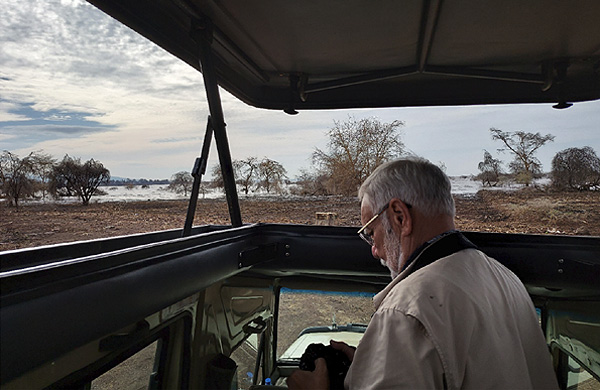 The menacing sky peeking through the opened roof above Steve in the land cruiser said it all. Those stringy clouds at 7:30 in the morning foretell a massive thunderstorm this afternoon. Yesterday afternoon we had the most extraordinary thunder imaginable, as if you were in the gods’ bowling alley during a weekend tournament.
The menacing sky peeking through the opened roof above Steve in the land cruiser said it all. Those stringy clouds at 7:30 in the morning foretell a massive thunderstorm this afternoon. Yesterday afternoon we had the most extraordinary thunder imaginable, as if you were in the gods’ bowling alley during a weekend tournament.
It’s Day 3 OnSafari and we’re in Lake Manyara National Park. When the rains just begin it’s so dry below and the cumulus storm clouds so large and high above that much of the water never reaches the ground. It takes several days of saturating the atmosphere before the waterfall begins.
But it’s terrifyingly different this year. Last year’s rains never fully stopped. The Great Rift Lakes didn’t recede as normal, so Manyara as you can see in the picture has overflowed onto its plains and its forests are being wet strangled.
This is climate change in Africa, and more broadly around all the world’s equatorial regions. It’s wetter than ever.
The first reaction is that this is good. But our morning in Manyara suggests otherwise.
One of Africa’s most beautiful trees is the yellow-barked acacia, or fever tree. There is no relationship between fever and yellow. Early colonialists watched Maasai stripping the bark and since early colonialists believed that all Africans got malaria from poor hygiene they called it the “fever tree” and avoided it like the plague.
Ironically what the traditional Maasai were doing was making a tea out of the bark for all sorts of medicinal uses including treating malaria fever!
The tree was one of the first to suffer from global warming. As beautiful and tall and branching that a healthy yellow-barked is, very slight temperature changes at night impede budding. The seeds are still a delicacy to elephants, whose numbers have surged in recent years.
So global warming reduced forest repopulation and the over population of elephants decimated the trees. After all, the only way to get to the high seeds is to push the tree down.
Where they best survived this double whammy was along lake shores. No one’s completely sure why, but perhaps because the water moderates the temperatures and although elephants swim they are more vulnerable in water than on land.
So some of the last great stands of yellow-barked acacia in Manyara are now dead as the result of a single massive year’s flood.
There are nearly a hundred species of equatorial shorebirds in East Africa, each with bills uniquely adapted to some unique shore food. Shrimp, molluscs, snails, water bugs and amphibians and frogs much less tiny fish of all sorts sustain the myriad types of food sources unique to all these different critters.
But these birds’ dinners aren’t microwaved out of the freezer. It takes time, sometimes years, for the shore ecology to develop the plant life that gives rise to the certain type of microscopic shrimp that the Kitlitz’ plover gorges itself on. Then it takes time for the food source to colonize large enough to feed the birds.
Manyara is a very shallow lake. Seven miles across at its widest, at most times of the year you can still walk across it: the slope is imperceptible. The lake bed’s flatness continues onto the guano-covered plains that depending upon how wet it’s been, is either grass on ground or little snail colonies in goop.
Dozens of these different food sources go dormant when the grass grows but explodes when the waters inch over them.
Now, everything’s been drowned. There’s nothing subtle about climate change. Everything is just happening too quickly.
We still saw elephants, hundreds of baboons, impala and bushbuck, buffalo and lots of cool birds but only 4 shorebirds of three species. With the menacing clouds in the sky, the oppressive humidity of just before the rains and the strong winds slapping waves against dead yellow-barks it seems an aftermath rather than the rebirth it should be.
S’bili kidogo. Africa might just be teasing me, again. Stay tuned.
Gibb’s Farm
5350′
S3.296883°
E35.66328°
Hi Jim – so sad not to be there with you and “ Mr. Steve”. Your descriptive writing has me there mentally. One of my favorite spots is Lake Manyara Tree Tops. Lions in the tree – feet from the road – pink flamingos- village with “hospital” with birthing room aka metal table!